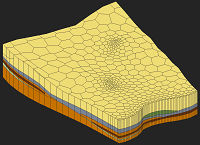GMS:UGrid Interpolation: Difference between revisions
From XMS Wiki
Jump to navigationJump to search
No edit summary |
No edit summary |
||
| Line 1: | Line 1: | ||
{{UGrid links}} | {{UGrid links}} | ||
<!--10.3 and older | |||
UGrid [[GMS:Datasets|datasets]] can be interpolated to other UGrids similar to how scatter point datasets can be interpolated to other objects. The '''Interpolate To''' command is found in the right-click menu of the UGrid dataset to be interpolated to another UGrid. This command opens the ''Interpolation Options'' dialog: | UGrid [[GMS:Datasets|datasets]] can be interpolated to other UGrids similar to how scatter point datasets can be interpolated to other objects. The '''Interpolate To''' command is found in the right-click menu of the UGrid dataset to be interpolated to another UGrid. This command opens the ''Interpolation Options'' dialog: | ||
| Line 38: | Line 40: | ||
*''New dataset name'' – Assigns a name to the new dataset created from the interpolation process. | *''New dataset name'' – Assigns a name to the new dataset created from the interpolation process. | ||
It is also possible to drag a UGrid dataset and drop it on to another UGrid to open this dialog and to indicate what the interpolation target should be. | It is also possible to drag a UGrid dataset and drop it on to another UGrid to open this dialog and to indicate what the interpolation target should be.--> | ||
==Points vs. Cells== | ==Points vs. Cells== | ||
